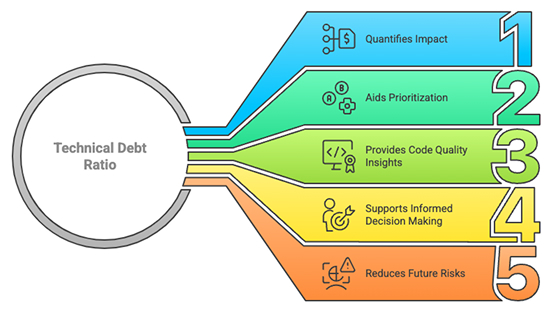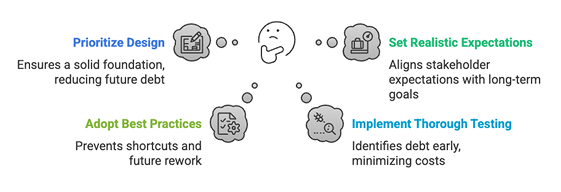In software development, teams often take shortcuts and implement quick fixes to speed up development. However, these shortcuts can introduce issues and bugs in the codebase, known as technical debt.
If technical debt remains unresolved, it will reduce the productivity and quality of the code while increasing the cost of additional rework. Teams use the technical debt ratio (TDR) to understand the cost of effectively addressing technical debt.
Concept of Technical Debt Ratio
The technical debt ratio (TDR) is a metric that quantifies the proportion of technical debt relative to the total development cost or effort. It helps teams understand the impact of unresolved debt on maintainability, predict future costs, and make informed decisions about refactoring vs. new development.
Importance of Measuring Technical Debt Ratio

Measuring the TDR provides various benefits. Here are a few common benefits that show the importance of measuring technical debt.
1. Quantifies the impact of technical debt
The technical debt ratio of new code provides a clear and numerical representation of how much additional effort or cost is needed to fix the technical debt. It helps stakeholders and teams understand the actual cost of the project, including unresolved technical debt and initial development cost.
2. Helps in prioritization
Monitoring TDR helps teams balance refactoring efforts with new feature development. However, not all technical debt needs immediate resolution. Some level of debt is acceptable as long as it does not slow down future development. Teams should focus on resolving debt that has the highest impact on performance, security, and maintainability.
3. Provides insight into code quality
A high TDR indicates that the current code base has significant technical debt, suggesting the need for more improvements and refactoring in the code base. Therefore, regularly monitoring the TDR can help track and maintain code quality.
4. Informs decision making
The technical debt ratio of new code helps stakeholders understand the development speed and long-term sustainability. It also helps them to make strategic, data-driven, and well-informed decisions without making assumptions.
5. Reduces future risks
Unresolved technical debt leads to bottlenecks and bugs that could cause system failure. Tracking TDR can help reduce, manage, and avoid risks, ensuring the project remains secure, stable, and scalable.
Types of Technical Debt
Here are some common types of technical debt:
- Code debt : Poorly structured or overly complex code that reduces maintainability and increases the cost of modifications.
- Design debt : Architectural flaws that limit scalability and flexibility in future development.
- Testing debt : Incomplete or missing tests that make debugging and validation harder.
- Documentation debt : Lack of proper documentation makes knowledge transfer difficult.
- Process debt : Inefficiencies in development workflows, such as slow CI/CD pipelines or outdated tooling.
Technical Debt Metrics
Measuring TDR can be done in two ways, based on effort or cost.
1. Effort-Based Calculation

If the measurements are done in person-hours or person-days, the technical debt ratio will be calculated like this:
- Total development effort : Total time spent on development, including designing, coding, testing, and deploying the software.
- Effort to fix technical debt : The estimated development time needed to fix all the known issues.
2. Cost-Based Calculation

If the measurements are measured in monetary cost, the technical debt ratio will be calculated like this:
- Total development cost : Total financial cost of development, including salaries, infrastructure, and tools.
- Cost to fix the technical debt : The estimated financial cost needed to fix all the known issues.
Maintaining a Favorable Technical Debt Ratio

Eliminating the TDR from a project entirely is not feasible, but teams can maintain a favorable TDR by following these recommendations:
- Prioritize design in the development process.
Bad design processes are the root cause of technical debt. Therefore, start with a solid and well-thought-out design before starting development. - Set realistic expectations with stakeholders.
Even though quick releases are tempting, it is better to take enough time to do things correctly and reduce technical debt. Therefore, it is important to ensure that stakeholders understand the long-term value of addressing technical debt. - Adopt industry best practices.
Always try to avoid shortcuts and follow the industry’s best practices to avoid technical debts and reduce costly rework in the future. - Implement thorough testing.
The testing process should not just check whether the features work as expected; it should also be used to check and identify any technical debt on the new code to reduce the rework costs early.
Limitations of Technical Debt Ratio
While the technical debt ratio is a useful metric, it also has a few limitations, including:
- Estimation accuracy challenges
Since TDR relies on estimated development costs and debt resolution efforts, errors in estimation can lead to misleading results. However, tools like SonarQube, CAST, and CodeScene can automate technical debt measurement by analyzing code complexity, duplication, and maintainability issues. - Difficulty in defining total development cost
Since the total development cost includes everything from the start to the end of a project, accurately defining the total development cost or effort is difficult in larger projects. - Varies across teams and projects
Different teams use different ways to calculate the TDR or estimate the cost or effort to fix it. This could be an issue when different teams work on different parts of the same project. They might follow different estimation approaches.
Conclusion
Technical debt ratio (TDR) is a valuable metric for assessing and managing technical debt in software projects. By tracking TDR regularly, teams can maintain code quality, balance refactoring with feature development, and optimize long-term project sustainability.
